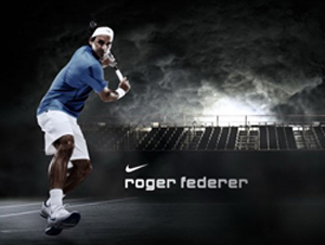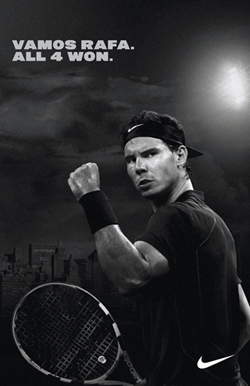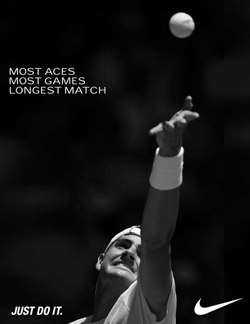 |
Roger Federer is a representative of Nike because they endorse him and during his matches he is decked out in their gear, a way for people all over to get a glimpse of the brand. In this particular ad, he is seen in a dark arena with a storm cloud brewing, which is signifying that when he arrives at the stadium, he should be the most frightening person there; similar to what happens when a storm rolls into town. His body posture and point of view allow the viewer to come to the conclusion that either we are the ball or there is a ball out of our sight. We are able to know this because of his forehand posture and the intensity in his face that he might have during a match. |
There are no direct icons presented, but we can assume that his headband and tennis shoes are icons as well as mortises because it "is an image of the product framed in some way" (Rose 90). These icons are signifying Nike because of the signature swoosh able to be seen by the viewer. Roger Federer has a level of intimidation present in this advertisement because of his facial expression and the shiny glare of sweat present on his body. He is there to take care of business and win, allowing him to play on his male identity in a male dominated sports world.
| In comparison to Federer, we have the Nike ad featuring Rafael Nadal, another tennis powerhouse and one of Federer's toughest competitors. Nadal is featuring that dominant look by his facial expression and the fist pump, allowing us to assume he does this a lot because he is so successful on the court. This is an example of Williamson's term, objective correlate, "transfers are often made so persuasively that certain objects become the objective correlates of certain qualities: certain objects become taken for granted as having certain qualities" (Rose 90). Through his look we can determine that a tough facial expression equals domination. The expression and fist pump are signifiers of winning along with Nadal because he has a determined look about him. Similar to Federer's ad, we know he means business and people should not mess with him especially on the tennis court because he could do some real damage to his opponents. The text, "Vamos Rafa. All 4 Won." is anchorage to his domination look. Vamos means 'go' in Spanish which is not uncommon for Nadal since he is from Spain and represents his country on the tennis court. By including this text, Nike is showing that they can appeal to not only Americans who enjoy tennis, but Spaniards as well who watch to support their fellow countryman. The "All 4 Won" is an example that everybody is behind him and will support him throughout all of his matches, no matter the outcome. |  |
It comes with no surprise that Nike has sponsored Nadal because of his success and they want their brand to have that accomplishment as well. Both he and Federer are wearing Nike clothing in their advertisements, another representation of how powerful the company is. They have the ability to endorse not only the #1 player in the world, but the #3 player, Federer, as well. Their ads also show that the two players want the best brand behind them and supporting them in their adventures, allowing us to understand why they have chosen to sponsor and be seen wearing Nike. The two advertisements from Nadal and Federer are in black and white adding to the fierce and athletic personalities being portrayed in the images. Black and white does this by letting the viewer focus solely on the image without becoming distracted with color or flowery components. The black and white gives off a boldness that brings out the masculinity of the men. We will see that this is different when comparing women's ads by Nike because they make them flashier in attempt to capture that sex appeal, something we do not see in the men's tennis advertisements.
 |
As tennis fans and sports fans in general know, the 2010 Wimbledon men's single match between John Isner and Nicolas Mahut set a record for being the longest match. It lasted eleven hours, five minutes and spanned over three days. It was talked about for days and from setting the record, Isner landed himself a Nike advertisement. The ad that he did featured the achievement he accomplished which is an objective correlate to strength and determination. For someone to be able to go that long in one single match and come out victorious is the ultimate sign of athleticism. Even though he lost in the next round, he was rewarded for his efforts by being selected to do this ad and hold the longest match record. Nike played off the match in the ad with the anchorage, "Most Aces. Most Games. Longest Match" and wrapped it all up in the left hand corner with their signature slogan, Just Do It. By adding that to the ad, they are saying it is as easy as you make it, no matter how long or strenuous the competition is, just do it. However, there is an absence in the advertisement because it takes two to play a tennis match and Nicolas Mahut was left out. The reason behind this could be that only the winner got the ad deal or that Isner was ranked, while Mahut was only a qualifier. A direct response to his absence we will never know, but can only speculate that Nike only wants to display their winners. |
This particular Nike ad brings up a question of how would the advertisement have been different if it was a women's match instead of a men's? "The topic of gender gap is becoming increasingly popular in politics, sports, advertising, education and employment" (Prakash and Flores 231). There is a gap on how women and men are displayed in advertisements. In sports advertisements this is especially true because the marketers know what sells and would rather create something that appeals to audiences and sells. The advertisers are sticking to the norm of sex selling that our society has created. This gender gap brings about the portrayal of women in tennis advertisements by Nike and how they differ from the three we have seen of Roger Federer, Rafael Nadal, and John Isner.